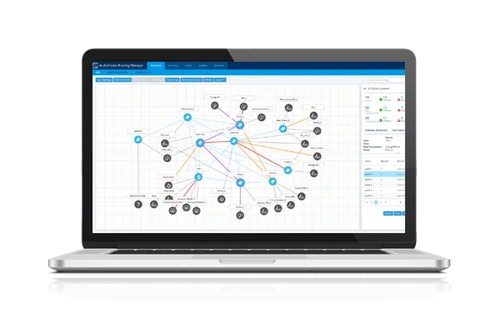RIMERA Energy
Voice network digital transformation using software-defined voice networking
- Home
- Success Stories
- RIMERA Energy
Background
RIMERA Group, the oilfield services division of ChelPipe Group, incorporates oil production equipment manufacturers and oilfield service providers, serving fuel and energy companies. RIMERA Group incorporates the leaders of the domestic oil and gas machine engineering – Alnas and Izhneftemash plants, as well as the RIMERA-Service network of service centres in key oil-producing regions of Russia.
Learn more about the RIMERA Group at the company’s website.
Challenges
Over the years, RIMERA had accumulated a wide variety of communications solutions at its different locations. These included PBXs and IP-PBXs from manufacturers such as Cisco, Panasonic and NEC. In recent years, the company had also begun to introduce unified communications to some of its employees in the form of Microsoft’s Skype for Business. Each site was connected to local telecom service providers via TDM or SIP trunks.
While this setup had served RIMERA fairly well over the years, it suffered from a number of drawbacks. For instance:
- Management of the voice network, and in particular call routing, was becoming increasingly complex.
- Inter-branch calls were conducted over public telephony networks resulting in high communications costs
- Migration to a standardized UC solution across the company would be complicated and involve significant disruption to RIMERA’s users
As part of its overall digital transformation process, RIMERA began to look for a unifying voice solution that would increase operational efficiency and pave the way for future migrations and lower communications costs, but without having to undertake a major replacement of existing systems.
Challenges
-
![]()
Complex network management
-
![]()
High communications costs
-
![]()
Migration to UC without disrupting users
“The Software-defined Voice Network approach enabled us to modernize our voice network without having to undertake a major forklift replacement of our existing telephony equipment, something that would have been extremely costly and disruptive to our users.”
Rustam Abdrakhmanov, CIO Chelpipe Group
Solution
RIMERA chose AudioCodes to deliver a voice infrastructure solution that would meet its requirements. There were several reasons for this, including AudioCodes’ vast experience in building complex voice enterprise voice networks, the breadth of its offering of products and solutions and the field-proven interoperability with TDM and SIP based systems, in particular Skype for Business.
The one truly unique aspect of AudioCodes’ offering, however, was its Software-Defined Voice Network solution or SDvN. Leveraging the principles of Software-Defined Networking (SDN), SDvN is an open solution designed to help large, distributed enterprises undergoing the digital transformation process to simplify the operations of their voice networks and increase call routing efficiency. SDvN achieves this through separation of the voice infrastructure and call routing control layers that enables consolidation of communications silos, connectivity with SIP trunk services and utilization of the corporate IP network to optimize call routing.
Using AudioCodes Mediant session border controllers (SBCs), RIMERA was able to link up its eight main sites and provide seamless connectivity between its on-premises PBXs, Skype for Business UC platforms and local telecom carriers. Legacy analog devices (such as analog common area phones, fax machines and other analog systems) were integrated into the network using AudioCodes MediaPack analog gateways.
The real game-changer, though, and the added ingredient that completed the SDvN solution was the AudioCodes Routing Manager or ARM. ARM is a powerful software solution that enables centralized control of all session routing decisions across enterprise voice networks. ARM separates call routing intelligence from the voice infrastructure to create an independent call control layer that oversees the entire voice network simplifying voice network management and helping save operational expenses. Instead of having to implement call routing and policy changes at each site individually, RIMERA’s IT team can achieve this from one location via ARM’s intuitive graphical interface. Furthermore, ARM’s open northbound interfaces enable RIMERA to easily add new services to their network when needed in the future.
With ARM in place, RIMERA was able to streamline their call routing management and introduce cost-saving policies. Calls between branches no longer travel over the PSTN but are routed - at no cost - entirely over the corporate WAN, while connections to external networks have been consolidated into a small number of locations.
RIMERA also employed the AudioCodes One Voice Operations Center (OVOC) to deliver centralized network device lifecycle management and voice quality monitoring. Using OVOC, RIMERA’s IT staff can configure and monitor their entire deployment of AudioCodes SBCs, gateways and IP phones wherever they are located in the network.
-
![]()
AudioCodes Routing Manager
AudioCodes Routing Manager (ARM) delivers a powerful, innovative solution by enabling centralized control of all session routing decisions.
Discover More
Results
The introduction of AudioCodes products and the SDvN solution into RIMERA’s corporate voice network has made a noticeable improvement to network efficiency and brought about significant cost reductions. The success of the deployment has not escaped the attention of ChelPipe, RIMERA’s parent company, which is now considering adopting the SDvN approach when modernizing its own voice network infrastructure during 2020.
“AudioCodes is a great partner who listens to our needs and helps us to solve problems rapidly and efficiently,” said Rustam Abdrakhmanov, CIO Chelpipe Group. “The Software-defined Voice Network approach enabled us to modernize our voice network without having to undertake a major forklift replacement of our existing telephony equipment, something that would have been extremely costly and disruptive to our users.”



